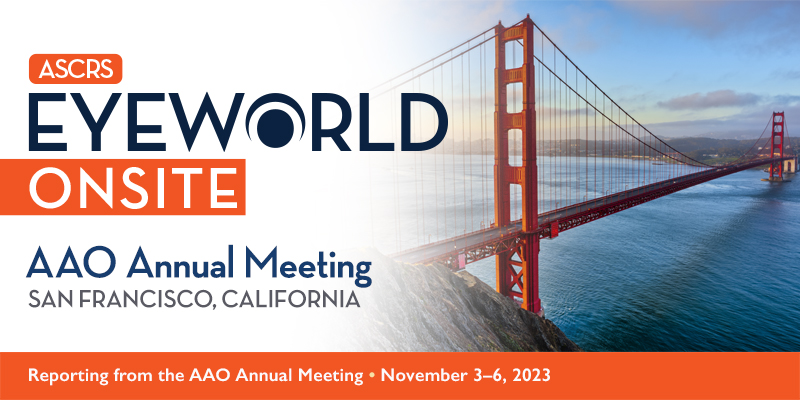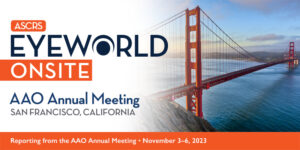
- Market overview
- Industry’s role in nurturing innovation
- The Winning Pitch Challenge
- Addressing what’s needed for successful innovation
- Artificial intelligence
Eyecelerator @ AAO 2023 kicked off with welcoming remarks from Stephen McLeod, MD, CEO, American Academy of Ophthalmology, Allen Ho, MD, Retina Program Director, and Gil Kliman, MD, Program Director.
Dr. McLeod said this is the largest Eyecelerator to date, with more than 1,000 participants. The Academy, with ASCRS, recognizes we play an important role in the whole ecosystem of innovation, he said. “This program is meant to bring together innovators and the people who support innovation.”
Dr. Kliman said that Eyecelerator is the largest innovation meeting in the world, largely because of the incredible constituency it has. “It’s a great meeting place for everyone to try to advance innovation,” he said.
Eyecelerator is a unique meeting, he said, because it is a joint venture between the two societies. Part of the theme is overcoming adversity and advancing innovation. Although it’s sponsored by clinical societies, it’s a business meeting that’s focused on business innovations, Dr. Kliman said.
Market overview
Kristen Harmon Ingenito of Market Scope gave a market overview. She highlighted some procedure trends in ophthalmology. In terms of surgical location, she mentioned simultaneous bilateral cataract surgery and the potential shift to more office-based cataract surgery. She also said that U.S. refractive surgery has mostly returned to pre-COVID-19 levels, and she addressed the global glaucoma procedure mix, noting that the vast majority of microstents and canal-based procedures are done in the U.S. There is a lot of potential for growth OUS. However, she noted that reimbursement in this area will play a key role. Dry eye is another exciting area, with several new pharmaceuticals.
When discussing new drugs, Dr. Kliman noted that one challenge is getting these to approval. He polled the audience on which product launch they are most excited about and think will exceed expectations in 2024, with the majority (37%) voting for Izervay (avacincaptad pegol intravitreal solution, Iveric Bio) for dry AMD.
Industry’s role in nurturing innovation
During a panel on industry’s role in innovation, the timing of the investment of money was discussed and how important it is for physicians and innovators to be able to partner with companies.
Kendra Hileman, Head of Instrumentation R&D, Alcon, discussed the company’s strategy, noting that Alcon hasn’t seen a decrease, but they often now acquire later in order to ensure the product is going to reach the market. She also discussed the Alcon Seed Fund, a program that was started last year to invest in smaller companies at earlier stages because they thought this was a gap that was being missed. She added that they’ve already had several significant investments in this area.
Philip Kowalczyk, Vice President of Business Development, Johnson & Johnson Vision, said that the company’s strategy is twofold, looking at attractiveness and fit. It starts with looking for unmet needs, he said. Within that, they also look at the science and technology’s ability to service those unmet needs and move to market. In terms of fit, he said the company evaluates the ability to get to the #1 or #2 space in the category and what it’s going to take from an investment sense to get there and stay there. “That’s how we look at any opportunity, whether it’s early or later stage,” he said, adding that they will apply different levels of waiting, depending on if it’s earlier or later stage.
At the end of the session, panelists shared advice for attendees. Sean Ianchulev, Eyenovia, said it’s important to learn quickly what needs to be done, and he stressed the importance of being brutally honest with what works and what doesn’t and move on.
Ms. Hileman said that the regulatory landscape has changed, and she stressed the importance of having clinical data to get approval in Europe and the U.S. Particularly in the U.S., study designs that are expected to support submission are more rigorous. Make sure you’re getting good regulatory advice and understanding what will be required from a clinal aspect, she said.
Mr. Kowalczyk suggested starting early. He said that credibility around hitting milestones is important. At the end of the day, any of decision is a leap of faith, so tying it back to what they’ve done and said they were going to do is important, he said.
The Winning Pitch Challenge
The popular Shark Tank-style competition was back at Eyecelerator, featuring pitches from three early-stage ophthalmology innovators, with judges and the audience deciding who took home cash prizes worth $45,000.
First place: David Kleinman, MD, MBA, Calm Water Therapeutics
Calm Water Therapeutics is a clinical stage ophthalmology company focused on antibody-drug conjugate (ADC) keratopathy, which is an orphan ocular surface disease. PEGPLUS is a proprietary multifunctional polymer that has demonstrated clinical safety and efficacy in dry eye disease.
The company is pursuing orphan drug designation and fast-track/accelerated approval for the drug product containing the proprietary multifunctional polymer, PEGPLUS.
The company has completed two proof-of-concept clinical studies of PEGPLUS-containing eye drops in dry eye disease. It was safe and well-tolerated across the board, Dr. Kleinman said. There were favorable results vs. standard of care comparator in both studies and improved signs and symptoms in chronic dry eye patients. Based on clinical data to date and the non-clinical efficacy data package, coupled with the overlay of dry eye symptoms and ADC keratopathy, Dr. Kleinman said there is proof of principal to move directly into a Phase 2 ADC keratopathy trial.
Second place: Niki Bayat, PhD, AesculaTech Humidifeye
Humidifeye is a personalized dry eye disease treatment to increase tear volume. This personalized punctal plug features a hydrogel material. The hydrogel adapts to the contours of the duct, turning to a soft, flexible solid. Additionally, the plug can be flushed from the punctum by room temperature saline irrigation. Dr. Bayat said this is the quickest and most efficient way to replace tears on the ocular surface.
Physician benefits are that it’s a 3-minute procedure (you can do both eyes in this time), there is no sizing required/low inventory cost, and it’s reimbursed under code 68761.
Humidifeye has successfully completed a first-in-human study, Dr. Bayat said, with 44 eyes, with 4 visits up to 3 months. She said that outcomes have been exceptional so far. Patient benefits include comfortable insertion, personalized fit, and no signs of dislodgement.
Third place: Oussama Boundaoui, MD, PhD, Regenoptics Tamponading Hydrogel
Current retinal detachment techniques boast 80% success, yet recovery is always described as the “worst weeks of my life,” Dr. Boundaoui said. NovaRetina is a tamponade agent to be used in retinal detachment procedures. The hydrogel can be injected into the eye through a cannula and resorbs and clears on its own after 4 weeks.
Advantages, he said, are there is no need for second surgery, there is 100% vision recovery postop, there are no restrictions on air travel, there is no need for difficult head positioning during recovery, there is minimal risk of cataract, and it’s cost effective. They are aiming for market launch in 2028.
Addressing what’s needed for successful innovation
Panelists in an afternoon session discussed key ingredients of successful innovation. Commenting on how much involvement and when is a good time for influence from clinicians and other stakeholders not involved in your company in the development of the product, Steve Pakola, MD, Chief Medical Officer, REGENXBIO, suggested to get them involved right away. Across the stakeholder spectrum, that should start early, he said. Everyone knows that intellectually, but it doesn’t always happen in practice, he added. At the early stage when you don’t have stakeholders, you have to proactively seek them out, he said.
Richard Small, CEO, Neurotech, said that one factor he thinks has contributed to success of the company is you need to have a great core technology. Equally important is you need a focused and dedicated work force, he said. You also need a supportive investor.
Panelists shared their ingredients for success. Mr. Small said it’s all about how you address bumps in the road and come together with the ability to make good, informed decisions.
Lori-Ann Christie, PhD, Principal, Visionary Ventures, said if you’re a small company, stay in touch with investors constantly. In an environment where there’s not a lot of capital to be had, constant recalibration of objectives will help you go further, she said.
Artificial intelligence
During a panel on artificial intelligence (AI), Kaushal Solanki, Eyenuk, discussed ways that AI can help healthcare providers. He described “spell-check AI,” which works in the background and checks for errors as you do regular work; “autonomous AI,” which automates routine work; and “superpower AI,” which lets you do things that are not possible otherwise.
How does this translate to actual products? He mentioned several Eyenuk technologies: EyeScreen, a spell-check AI for screening and diagnostics that puts AI in the background to flag errors; EyeArt, an autonomous AI eye screening robot for primary care providers; and EyeMark, a superpower AI, which has lesion analysis and longitudinal monitoring to help find the smallest changes and turn these into biomarkers that can correlate to future progression of diseases. They are now adding diseases to the frameworks of these tools.
EyeWorld Onsite is a digital publication of the American Society of Cataract and Refractive Surgery.
For sponsorship opportunities or membership information, contact: ASCRS • 12587 Fair Lakes Circle • Suite 348 • Fairfax, VA 22033 • Phone: 703-591-2220 • Fax: 703-591-0614 • Email: ascrs@ascrs.org
Opinions expressed in EyeWorld Onsite do not necessarily reflect those of ASCRS. Mention of products or services does not constitute an endorsement by ASCRS.
Click here to view our Legal Notice.
Copyright 2023. All rights reserved.


